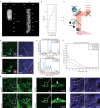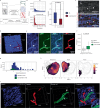Deep intravital brain tumor imaging enabled by tailored three-photon microscopy and analysis
- PMID: 39256378
- PMCID: PMC11387418
- DOI: 10.1038/s41467-024-51432-4
Deep intravital brain tumor imaging enabled by tailored three-photon microscopy and analysis
Abstract
Intravital 2P-microscopy enables the longitudinal study of brain tumor biology in superficial mouse cortex layers. Intravital microscopy of the white matter, an important route of glioblastoma invasion and recurrence, has not been feasible, due to low signal-to-noise ratios and insufficient spatiotemporal resolution. Here, we present an intravital microscopy and artificial intelligence-based analysis workflow (Deep3P) that enables longitudinal deep imaging of glioblastoma up to a depth of 1.2 mm. We find that perivascular invasion is the preferred invasion route into the corpus callosum and uncover two vascular mechanisms of glioblastoma migration in the white matter. Furthermore, we observe morphological changes after white matter infiltration, a potential basis of an imaging biomarker during early glioblastoma colonization. Taken together, Deep3P allows for a non-invasive intravital investigation of brain tumor biology and its tumor microenvironment at subcortical depths explored, opening up opportunities for studying the neuroscience of brain tumors and other model systems.
© 2024. The Author(s).
Conflict of interest statement
F.W. and W.W. report the patent (WO2017020982A1) “Agents for use in the treatment of glioma.” F.W. is co-founder of DC Europa Ltd (a company trading under the name Divide & Conquer) that is developing new medicines for the treatment of glioma. Divide & Conquer also provides research funding to F.W.’s lab under a research collaboration agreement. The remaining authors declare no competing interests.
Figures








References
Publication types
MeSH terms
Grants and funding
- 951991, Brainiaqs/European Commission (EC)
- DFG: SFB 1389/Deutsche Forschungsgemeinschaft (German Research Foundation)
- DFG: VE1373/2-1/Deutsche Forschungsgemeinschaft (German Research Foundation)
- DFG: BR 6153/1-1/Deutsche Forschungsgemeinschaft (German Research Foundation)
- 507778602/Deutsche Forschungsgemeinschaft (German Research Foundation)
LinkOut - more resources
Full Text Sources
Medical

